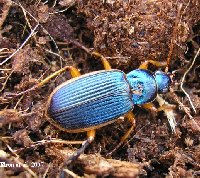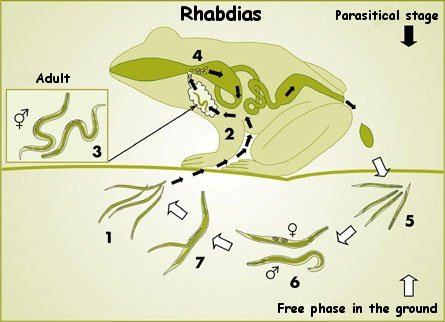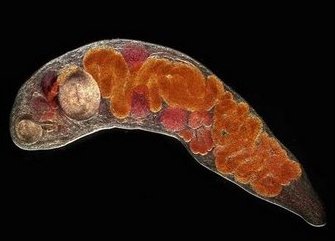Parasites and Frog Health
Parasites
 Parasites in frogs are very debilitating, even causing death. Nematodes and other
families of parasitic worms often have other "carriers" that then infect the frogs.
Sometimes the frogs have directly picked them up in the wild, and were never
quarantined by persons who then bred the frogs, nor the petshop. (A good rule of thumb
for quarantine is 3 months). Those brought into the pet trade
industry by catching wild amphibians, must adhere to the rules of CITES. These are
to be quarantined for 3 months as well.
Parasites in frogs are very debilitating, even causing death. Nematodes and other
families of parasitic worms often have other "carriers" that then infect the frogs.
Sometimes the frogs have directly picked them up in the wild, and were never
quarantined by persons who then bred the frogs, nor the petshop. (A good rule of thumb
for quarantine is 3 months). Those brought into the pet trade
industry by catching wild amphibians, must adhere to the rules of CITES. These are
to be quarantined for 3 months as well.
Still, some worms can "hide-away" and go undetected. Others harbor themselves, unseen; in the aquarium waters at the petshops...do you really think they ever quarantine a potentially threatening tank when it could be making them money? I think not. (At least the larger chain store style petshops).
And lets not forget, that today many petshops are using filtration systems connecting many tanks all to one another. This creates an even bigger threat for the aquatic frog species, who now are 'swimming' in water from half the other fish, snail, invertebrates, etc. in the entire store!
 Several years back, I bought 3 different species of frogs (all terrestrial or tree type) from our local Petco, in amounts of 3 to 6. Each specie was housed separately,
and since the Petco was brand new, I felt safe that the vivariums they were housed in had not previously housed other herp species.
No quarantine was required on my part, as they would be the only
animals in their own species tanks at my place.
Several years back, I bought 3 different species of frogs (all terrestrial or tree type) from our local Petco, in amounts of 3 to 6. Each specie was housed separately,
and since the Petco was brand new, I felt safe that the vivariums they were housed in had not previously housed other herp species.
No quarantine was required on my part, as they would be the only
animals in their own species tanks at my place.
Sadly, every single one of 2 of the 3 species of my frogs ended up having to take de-worming treatment! Their vivariums had to be broken down, everybody went to hospital tanks, and it took me about 3 months to finally cure all of those frogs.
The reason for telling you this story? Even if you think your frogs were in a parasite free place, you may end up treating them for worms anyway.
And...every time you add a new animal, even of a different type...(say you add a black molly to a dwarf pipid tank) the potential for the molly to cross-infect the frog is certainly there.
Snails with Frogs
It is strongly suggested to never house snails of any kind with any of your aquatic frogs. They can be carriers of worms. The worms won't kill the snails, but the trematodes living in them mature into cercariae. At this point, they need to find a new host. In many cases, this is your pet frog. By the way, just because your froggy is doing well for quite some time with snail, (even a year or more) does not mean that the snail 'is clean'. Only that the trematodes may not have fully developed yet.
 Since there are very few cures for invertebrates (snails & trematodes are both inverts)
even if you got the worms out of the snail through treatment, the treatment itself would
in most cases kill the snail as well. Ribeiroia snails can also carry flatworms
and these parasites have been linked to some of the frog deformities in
North America.
Since there are very few cures for invertebrates (snails & trematodes are both inverts)
even if you got the worms out of the snail through treatment, the treatment itself would
in most cases kill the snail as well. Ribeiroia snails can also carry flatworms
and these parasites have been linked to some of the frog deformities in
North America.
NOTE: An astute member of the British website ReptileForums.co.uk , ilovetoads2 mentions that this would apply to terrestrial snails as well, due to how they lay their eggs and terrestrial frogs come into contact with them. He/She is entirely correct! To read their entry, Click Here. Thanks 'ilovetoads2', for bringing up that important point!
To top off this parasitical mess, Nematodes can also be a problem in the case of the Rhabdias worms infecting the snails.
Back to the frogs. Not to worry, many can be helped, perhaps even cured if you're diligent. I would suggest though, that keeping your own newly acquired pets separated from main tank for a period of 3 months is not such a bad idea. Patience here is truly a great virtue.
Make sure to read the Quarantine page for all the help you'll need with this subject.
Rhabdias
 Rhabdias is a parasitical health concern to amphibians.
Nematodes such as Rhabdias (strongyloid lungworms) may cause pneumonia and failure
to thrive. Adult worms are found in the lungs. Eggs and larvae are present in the
gut in large numbers and can be found in the coelomic cavity and lymph spaces in
severe infestations.
Rhabdias is a parasitical health concern to amphibians.
Nematodes such as Rhabdias (strongyloid lungworms) may cause pneumonia and failure
to thrive. Adult worms are found in the lungs. Eggs and larvae are present in the
gut in large numbers and can be found in the coelomic cavity and lymph spaces in
severe infestations.
As with all parasites, separate suspected frog to one hospital tank each. Feed the frog(s), and wait for a faeces. If you are treating more than one, label each tank, and the faeces found next morning the same. Have it examined for the presence of worms. If you're in any kind of educational institution, your science lab should have microscopes. Have the teacher help you with species identification. If no school is available, try taking the faeces to your local vet. He should have the plate books needed to identify the parasite, if in fact one is present.
If their presence is determined, most likely all frogs in the vivarium should be treated for this. If one has it, they all probably do.
 Therapy of choice for Rhabdias is usually
Ivermectin at a dose
of 0.5 milligrams per kilogram in distilled water. Pour treated water
into clean jar. Using an eyedropper, place 3 drops of the medication onto the
frogs' dorsum.
Therapy of choice for Rhabdias is usually
Ivermectin at a dose
of 0.5 milligrams per kilogram in distilled water. Pour treated water
into clean jar. Using an eyedropper, place 3 drops of the medication onto the
frogs' dorsum.
This has proven to be safe. Do this to each individual one time, then repeat the treatment every 10 days for a total of three treatments. Use of the 0.2 milligrams per kilogram is recommended for the second and third treatments.
Re-infestation can occur rapidly so tank disinfection combined with the repeated administering is necessary but is not proven to work on lungworms.
Keep him/them in observation for another two weeks after last treatment session. Look for complete skin-shed. (For more on skin-shedding, Click Here.
Mites
 Herp type mites (Trombiculids) can cause areas of redness seen on frogs or toads. Mites have eight legs and are as small or smaller than fleas. Use a magnifying glass and handle the frog with gloves, checking closely on affected areas for the miniscule arachnids. In the case of mite infestation, the reddened areas will be tiny spots,
(the actual mites) and not a solid patch or patches of reddened areas. If the area(s) are solid, check for red leg or septicemia symptoms.
Herp type mites (Trombiculids) can cause areas of redness seen on frogs or toads. Mites have eight legs and are as small or smaller than fleas. Use a magnifying glass and handle the frog with gloves, checking closely on affected areas for the miniscule arachnids. In the case of mite infestation, the reddened areas will be tiny spots,
(the actual mites) and not a solid patch or patches of reddened areas. If the area(s) are solid, check for red leg or septicemia symptoms.
Open a Tetracycline capsule and empty into a 1/4 cup of distilled water. Swirl to mix well. Place a few drops of the yellow liquid onto the infested frog's dorsum. Retreat the frog 24 hours later with the refridgerated (and then cooled back to room temperature) tetracycline mixture. Discard after the second treatment. This should clear up the mites. Cleaning and sterilizing the entire vivarium will help to stop reinfestation.
Spirometra
 One of the most horrible parasites infecting frogs so far is a species of tapeworm
called Spirometra erinacei. It becomes a breeding adult once
it has been picked up by house cats. Larvae are passed to wild
(or your wild caught) frogs
when the cat leaves them behind on soil. The worm then migrates through several
internal organs in the frog, causing extensive damage as it passes through them.
Eventually it digs into the frogs' muscular tissues in his thighs.
One of the most horrible parasites infecting frogs so far is a species of tapeworm
called Spirometra erinacei. It becomes a breeding adult once
it has been picked up by house cats. Larvae are passed to wild
(or your wild caught) frogs
when the cat leaves them behind on soil. The worm then migrates through several
internal organs in the frog, causing extensive damage as it passes through them.
Eventually it digs into the frogs' muscular tissues in his thighs.
 Once the Spirometra makes it into the muscle, it begins "eating", or liquifying the
tissue, even causing the pelvic bone to become brittle and break. The frogs' immune
system is attacked here too, because he has several lymph glands in this region of
his body. The worm(s) then affect the skin surface of the poor frog. This weakens
of course, allowing more pathogens to infect the frog.
Once the Spirometra makes it into the muscle, it begins "eating", or liquifying the
tissue, even causing the pelvic bone to become brittle and break. The frogs' immune
system is attacked here too, because he has several lymph glands in this region of
his body. The worm(s) then affect the skin surface of the poor frog. This weakens
of course, allowing more pathogens to infect the frog.
So far, there has not been discovered any medication which kills the worms without also killing the frog. All you will be able to do is bring the infestation under control so that the wounds can heal and lymph sacs are reduced. The frog will still need to be re-medicated whenever the worms become annually re-active. He surely will still remain in intense pain from organ damage...
With that said, sparing the frog the treatment (which is painful & toxic) is at this time the best thing you can do for him. You did see the picture of the infected Australian treefrog up there on your right? He suffered indeed. Trying to medicate the animal risks contamination of other frogs at your home and in the wild. Do you and the animal a favor by properly and painlessly Euthanizing him.
 For more information on Spirometra, visit
The FDR Project.
For more information on Spirometra, visit
The FDR Project.


